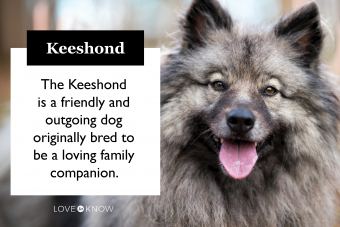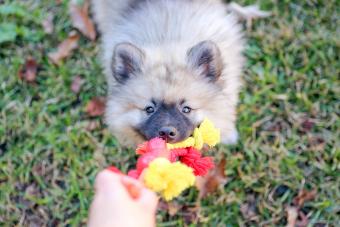
The Keeshond, pronounced "kays-hond," is a friendly and intelligent medium-sized breed. These dogs were originally bred to serve as companions, so they make very devoted and loving family members. Discover more about the stunning Keeshond breed and whether one of these dogs would be a good fit in your home.
Breed History and Origin
The Keeshond is quite an old breed with a long history. They originated in the Netherlands and Germany around the 18th century when they reportedly served as companions and watchdogs. Because of this role, the Keeshond earned the nickname of "Dutch Barge Dog." Some say the breed name comes from the Dutch patriot and politician, Cornelis de Gyselaer; his nickname was "Kees," and "hond" means dog in Dutch. These dogs are said to be a mixture of spitz-types, the Norwegian Elkhound, Samoyed, and Pomeranian.
Keeshonden were brought to England in 1905 and later to the United States in 1923. The breed quickly grew in popularity due to their well-mannered and friendly nature as a result of being bred specifically as companion dogs. They were officially recognized by the American Kennel Club (AKC) as members of the Non-Sporting Group in 1930.
Characteristics of the Keeshond
In addition to their impressive coat, Keeshonden have numerous desirable and distinct characteristics.

Appearance
Keeshonden have a striking appearance. The first thing you'll likely notice about one is their thick, luscious coat. This breed has a double coat, meaning they have a soft undercoat and a longer "guard" coat on top. The fur is long all over the body, but is especially pronounced around the neck, creating a lion-like mane. The fur on their tail is plumed. Their long coat is a standard combination of silver, creams, and black, though the exact shade and saturation varies from dog to dog. They tend to have dark shading around the muzzle, eyes, and ears.
Underneath their fur, these dogs have a sturdy body structure. They have a square head with medium-length muzzle and erect, triangular ears. Their characteristic tail is curled and sits high. Keeshonden stand 17 to 18 inches tall at the shoulder and weigh an average of 35 to 45 pounds.
Temperament
Keeshonden are notoriously intelligent. They're also friendly and outgoing, which makes them excellent companion dogs. This is no surprise, considering they were bred for this purpose. They tend to get along with all people, other dogs, children, and small pets, and can fit in nicely with any household or lifestyle.
These dogs become very devoted to their owners and may demand continuous attention. However, this trait can cause Keeshonden to develop separation anxiety when they're not around their family. Proper training from a young age can help deter negative behaviors and allow your Keeshond to tolerate being alone when needed.
These dogs are excellent watchdogs and will bark to alert their owner, though they rarely yap for their own pleasure, like some other breeds. Due to their thick coat, they do well in cold climates but may not be ideal for places with hot weather.
Exercise Requirements
Keeshonden have moderate exercise requirements and need about 60 minutes of movement each day. They can do well with this time broken into two daily walks or a long hike or play session occasionally. The breed needs to exhaust any excess energy they might have, but they'd also be content by your side in the house most of the day.

However, if you're interested in pursuing dog sports with your Keeshond, you're in luck. These dogs can be very successful in agility and other athletic sports because of their intelligence and athletic build.
Training
This breed is known to be easy to train as a result of their smart nature. They're eager to please their owners, which makes learning queues and commands much less challenging. However, it's always important to begin training at a young age. Doing so will help prevent any bad and potentially destructive behaviors. This is particularly critical because this breed can act as "Velcro" dogs and experience separation anxiety when left alone.
The Keeshond is friendly with most people and pets, but early socialization is still necessary. Get your Keeshond used to meeting new people so they mature into a well-rounded and adaptable pet.
Health Concerns
Keeshonden are generally healthy dogs, but they may be prone to some genetic diseases that potential owners should be aware of.
- Addison's disease: Addison's, or hypoadrenocorticism, is an underproduction of natural steroids by the adrenal glands.
- Hyperparathyroidism: Primary hyperparathyroidism (often abbreviated PHPT) can occur as a congenital disease in Keeshonden whereby the parathyroid glands produce too much parathyroid hormone.
- Eye disorders: The breed may be at higher risk for eye problems, including progressive retinal atrophy and glaucoma.
- Heart conditions: These dogs can develop mitral valve insufficiency (MVI), which involves wearing of the mitral heart valve.
- Epilepsy: Keeshonden are prone to an inherited seizure disorder, idiopathic epilepsy.
- Elbow and hip dysplasia: Abnormal growth of the hip and elbow joints can lead to pain, limping, and arthritis.
- Luxating patella: The breed may be predisposed to this knee disorder, which involves the kneecap slipping in and out of place.
Lifespan
The average lifespan on a Keeshond is between 13 and 15 years. Proper care, including a nutritious diet, will help your Keeshond live a full and happy life.
Grooming
Given the breed's thick coat, grooming is something Keeshond owners must become familiar with. Brushing should be done at least weekly to remove loose hair and prevent mats from forming. Most owners prefer a slicker or pin brush.
Keeshonden are moderate shedders for most of the year but become heavy shedders when they "blow" their coats twice each year. During this seasonal shedding, they lose their undercoat. Regular brushing can be helpful during these high-shedding periods to keep your dog comfortable.
You can give your Keeshond a bath every six to 12 weeks or as needed. Many owners elect to bring their dogs to the groomer for this, but you can certainly keep your dog clean at home.
Fun Facts About the Breed
- It's a little-known fact that the plural form of Keeshond is not "Keeshonds"; it is "Keeshonden."
- Some people call the breed kees -- pronounced "kays" -- for short.
Where to Buy or Adopt a Keeshond
If you're interested in adding the lively Keeshond to your family, you'll likely pay anywhere from $1,000 to $2,000 or more for a well-bred puppy. The Keeshond Club of America has a breeder directory available based on location. They also offer potential owners an in-depth buyers guide to finding and working with a high-quality breeder. As they mention, "A Quality Puppy is Worth the Wait." The AKC Marketplace also lists available Keeshond litters for sale.

In addition, several Keeshond rescues can help you find a puppy or adult dog in need of a home. Some of these organizations place dogs only within their region, whereas others are eager to find homes for adoptable dogs anywhere in the United States. The following resources can aid in your search.
Is the Keeshond the Right Breed for You?
If you're looking for a kind, good-natured dog that will get along with everyone in the house, the Keeshond could be the perfect fit. These dogs aren't elite athletes, though they do need at least one hour of physical activity each day. Your Velcro Keeshond will remain by your side as a loyal and trusted companion. Just note that their abundant fur may also stick to you like Velcro!







